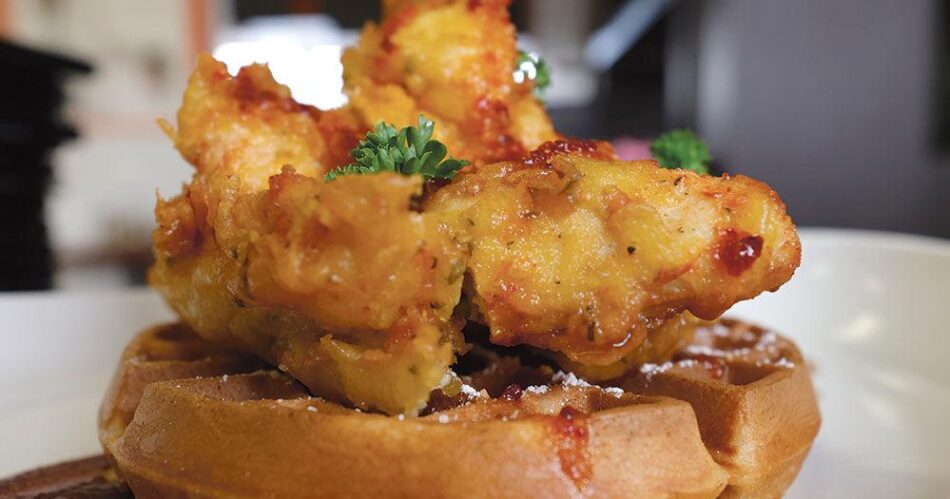A story about the origin of chicken and waffles circulated for years – long enough to gain credence. It told how jazz musicians, tired from a long night performing in Harlem clubs and quite hungry, found the kitchen staff preparing waffle batter for the breakfast crowd. There was, at least, a batch of fried chicken left over from dinner.
Two and two together, and the Jazz Age was responsible for an American favorite.
Of course, it’s just a story. There are dozens of published references to the dish dating back to the 1850s – not from the South, as one might suspect, and definitely not from New York, but from the southeastern swath of the Keystone State known as Pennsylvania Dutch country.
The popularity of the dish nationwide is a fairly recent phenomenon, however.
“Depending on one’s generation, the mere thought of having fried chicken and waffles on the same plate for most is unheard of,” observes Benjamin Brown, executive chef for The Lodge at Pebble Beach. But in an era of culinary innovation, the combination of breakfast on a plate with lunch and dinner, of sweet and savory, does not seem so outlandish.
“Those who have never tried the delicacy before often will order the dish and become fans,” Brown adds.
Fried chicken is plated with waffles and drizzled with a spicy hot honey at The Gallery Cafe in Pebble Beach, a feature on the breakfast menu. Brown adds crispy bacon to the dish, as well. (“Why not?” he says. “Slight smoke flavor and some amazing umami.”)
The versatility – at Nora’s in Carmel the chicken is bone-in, for example – has allowed chicken and waffles to ease onto lunch and dinner menus, as well. And it is threatening the brunch status of Benedicts and omelettes.
At The Grill at Point Pinos in Pacific Grove, chicken and waffles is in the top three of brunch items ordered. “You get a little of everything,” says General Manager Karren Vidales. “It gives a balance – a little spicy, a little sweet.”
Early mentions of the dish suggest that before popular taste tipped to Southern-style fried chicken, it was even more diverse. Among them are recipes with broiled chicken, shredded chicken, chicken a la king over waffles and more. There was even a catfish and waffles craze that petered out – thankfully – by the 1920s.
“There are several different strains or variations of this dish, with their own lines of evolution, but they are often conflated into one oversimplified narrative,” culinary historian William Weaver pointed out in a Pennsylvania Heritage article.
Kitchen staff at The Grill at Point Pinos smother the chicken in their signature spicy sausage gravy – a throwback to one of the favorite versions of the late 1800s. The result is a heftier dish, one that is at once rich and rustic, searing and sweet. The house waffle batter at the restaurant carries a malty comfort. But it is the gravy over chicken that has been brined overnight in buttermilk that sets the dish apart.
“The waffle is just a bonus,” Vidales says.
Oddly enough, chicken and waffles was considered a special occasion dish into the early 20th century. And it may have remained a regional dish. In 1908, the Griswold Manufacturing Co. took out a patent on a waffle iron suitable for mass distribution.
Of course, that alone would not have popularized chicken and waffles. Weaver points out that many food writers, as well as many origin stories, place the creation of the dish in New York or, more likely, the Deep South. But he calls this a matter of conjecture.
While Pennsylvanians prepared the chicken in different ways, it is possible that the migration of Black people from the South to Northern cities brought fried chicken to the forefront. Or not.
“The reality is that Southern cooks have embraced something created outside the region and have since integrated it into their cuisine,” Weaver observes.
Jazz musicians of the 1930s seeking a meal in the early hours does make for a compelling tale. But for Brown, the different possibilities are part of what creates interest in the dish.
“With so many cultural variations, the breakfast item has become a way for chefs to put their spin on the dish, making it popular,” he says.




